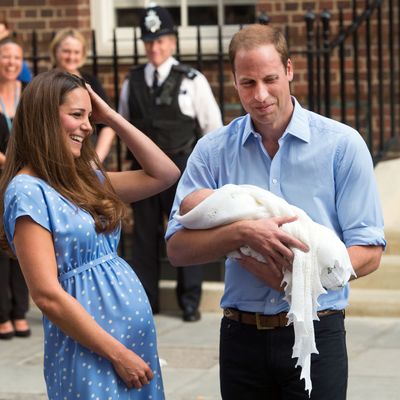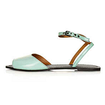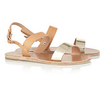
When Kate Middleton left the hospital with her husband and baby yesterday, she chose to wear an empire-waist dress, cinched loosely with what designer Jenny Packham described as a “self-belt.” Like any woman who has just given birth, she still looked pregnant. Most women only lose about ten pounds during birth, including the baby itself, the placenta, and amniotic fluid, but lots of remaining fluids stick around for several days, causing a post-birth belly. This is normal.
But what set off a flurry of comments around the Internet, as well as an article by the Daily Beast’s royal correspondent, Tom Sykes, was that she had been so bold as to allow her midsection to protrude. Sykes writes:
Given the microscopic level of scrutiny of this young woman’s body over the past nine months, one could hardly have blamed her if she had held the baby protectively in front of her to shield her body from the cameras, but no. This thoroughly modern royal was apparently determined to lend a helping hand to women everywhere who have just given birth, and shatter one of the last taboos of pregnancy — the post-baby belly.
Although post-baby bellies happen to everyone, even the Beyoncés and the Giseles of the world, it’s customary for famous new moms to hide themselves until it’s all gone. Princess Diana, who also made a public appearance with 1-day-old Prince William in 1982, covered up her body in a tentlike dress, and celebrities who can’t resist sharing pictures of themselves after birth stick to head shots, under-the-covers shots, or shots with their tummies otherwise hidden. Victoria’s Secret model Miranda Kerr was more than willing to show herself nursing, but not anything below her waist. The post-birth belly has no place in celebrity imagery.
Belly denial seems closely tied to the well-documented fetishization of celebrities’ miraculous post-baby weight loss. Famous pregnant women are not only glorified for reclaiming their flat-tummied physiques, they’re expected to. It’s practically a rite of passage for Victoria’s Secret models to reappear on the runway within months of giving birth, sending the Internet into fits of “post-baby body” headlines. Some women even make money off of it: Jessica Simpson got a Weight Watchers contract after her first baby, and Kim Kardashian was rumored to be shopping around for weight-loss-endorsement deals while she was pregnant with North West.
But it’s odd that the post-birth belly is considered so novel in our current age of baby-bump fascination. Why is this section of time — the few days or maybe weeks after birth — so taboo? It’s as if a woman’s body isn’t worth appreciating if it’s not either pregnant or remarkably slender, even if she’s just spent hours squeezing eight pounds and six ounces of baby boy out of her vagina. For all the public’s eagerness to celebrate pregnancy, there’s a woeful intolerance — or even misunderstanding — of the actual process, which doesn’t end right at birth.
So was Kate brave to show her belly yesterday? Perhaps. There’s no doubt it was intentional. Everything she wears is always carefully considered, and the dress was custom-made for her. But Kate’s public role is that of wife and mother. While her identity is certainly tied to her physical appearance, she has nothing to gain by hiding her maternal features. If only more women felt this way.









